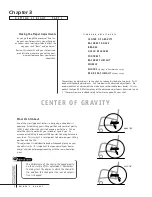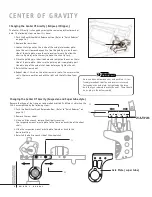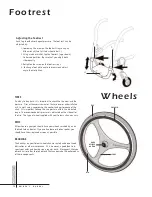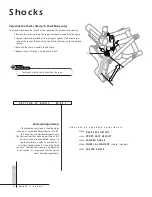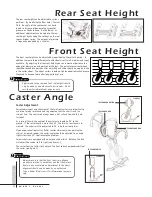
C H A P T E R 1
SAFETY TIPS . . . . . . . . . . . . . . . . . . . . . . . .
C H A P T E R 2
GETTING TO KNOW YOUR CHAIR . . . . . . . . . . .
COLOURS EVERY DAY CHAIRS
C H A P T E R 3
GETTING IT RIGHT . . . . . . . . . . . . . . . . . . . .
Part 1
Standard adjustments/ Center of Gravity
Part 2
Advance adjustments . . . . . . . . . . . . .
C H A P T E R 4
MAINTENANCE, WARRANTY & ACCESSORIES . . . .
Center of gravity (SABER) . . . . . . .
Backrest angle . . . . . . . . . . . . . . .
Brakes . . . . . . . . . . . . . . . . . . . .
Quick releases . . . . . . . . . . . . . . .
Footrest/ Wheels . . . . . . . . . . . . .
Backrest height/shocks . . . . . . . . .
Rear seat height . . . . . . . . . . . . . .
Front seat height . . . . . . . . . . . . .
camber angle . . . . . . . . . . . . . . . .
Caster Housing (SABER) . . . . . . . . .
Camber/ Wheel Alignment . . . . . . .
Service & maintenance . . . . . . . . .
Maintenance schedule . . . . . . . . . .
Troubleshooting . . . . . . . . . . . . . .
Warranty . . . . . . . . . . . . . . . . . . .
Accessories . . . . . . . . . . . . . . . . .
Register Card . . . . . . . . . . . . . . . .
1
2
3-4
5
6
7
8
9
9
10
11
11
12
12
12
12
14
15
15
16
16
17
17-18
19
C
O
N
T
E
N
T
S
Always start slowly. You will grow into the feel of your chair. By trying to do to much to soon, you
could run the unnecessary risk of injury to yourself and others.
Have someone assist as you familiarize yourself with your wheelchair. Each new maneuver could pose a
potential risk of injury. Backward movements are especially tricky. Always have someone working with
you until you attain a level of proficiency when operating your wheelchair. Whenever anyone assists
you, it is important that they too read the owners manual prior to getting started.
Avoid unnecessary risks such as high speeds, quick turns and leaning backward. In addition, avoid
running over objects which could cause you to stop suddenly or capsize.
You should always perform a safety check of your wheelchair before each use.
Talk to your doctor, nurse or therapist prior to operating your wheelchair to determine safe methods of
operation that suit you best.
Certain shifts in your weight while dressing or performing a physical activity may create a potential
hazard. If these functions are not done properly, they could result in a fall or capsizing of the chair.
To help prevent this:
1. Position the front casters forward.
2. Make sure the anti-tippers (if installed) are locked and in the downward position.
3. Move the rear of the chair so that it is against a wall.
4. Lock both rear wheels.
S
A
F
E
T
Y
T
I
P
S
P A T I E N C E
T E A M W O R K
C O N T R O L
S A F E T Y C H E C K
C O N S U L T
W E I G H T S H I F T
Chapter 1
ii
O W N E R ’ S M A N U A L







